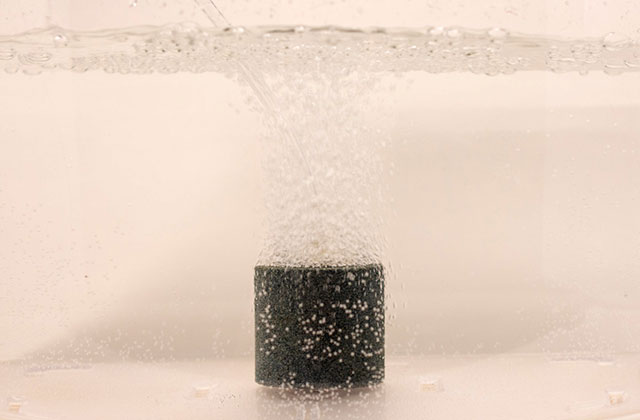The O2 Grow system uses electricity to deliver pure oxygen right into your reservoir, not just an aquarium bubbler reformatted for a hydro reservoir. This unique product uses electrolysis to oxygenate water for increased plant growth. High Times did a side-by-side test of the O2 Grow and a traditional air stone bubbler, and found it provided 26% more dissolved oxygen (DO).
Water pent up in closed reservoirs doesn’t have a natural input of oxygen, so hydro growers need a way to reintroduce the oxygen their roots consume to keep healthy plants. For making compost teas you need a supply of oxygen as well, or else the bad anaerobic bacteria will take over.
Traditional bubblers use a noisy and high wattage pump to force air through an air stone, a porous rock that disperses a stream of air into a bunch of bubbles. More expensive air stones, often called diffusers, can be made of ceramic or another porous material like silica. By generating smaller bubbles the air comes into contact the water with a larger surface area, so oxygen has a greater opportunity to dissolve into the water. Because these bubbles provide a slow source of oxygen, they mostly need to be run 24/7. The O2 Grow provides a lasting amount of DO in three, six or ten hours depending on the volume of water.
Regardless of whether a bubble diffuser is cheap or expensive and high tech, it will always have one major limiting factor: air is only about 21% oxygen gas; nitrogen comprises the rest, with just a touch of argon.
This device uses electricity to literally split H2O into hydrogen gas (H2) and oxygen gas (O2) in a process known as electrolysis that has been around for over 200 years. In the O2 Grow, electrolysis happens on a special grate; part of the oxygen gas immediately dissolves in the water and the less soluble hydrogen gas bubbles out. Safety testing has shown the hydrogen does not present a significant fire hazard, but it is flammable.
Putting It To the Test
To test the O2 Grow we filled a little fish tank with 420 cubic inches of reverse osmosis filtered water at 77 °F. A DO meter from Hanna Instruments measured the water at 7.8 mg/L of DO, or 92% saturation for that temperature. We put an O2 Grow 2020 into the tank and turned it on. As soon as all the little bubbles started to form on the plate the Hanna meter read an increase in DO, and it steadily climbed until it reached 8.3 mg/L after only a minute and a half.
Designed to oxygenate five gallons of water in three hours, we ran the O2 Grow for 42 minutes in our 420 cubic inches of water, a rough scale-down. With the device still running the DO meter read anywhere between 11.2 mg/L and 13.5 mg/L. After it was turned off the water was 131% saturated with 11.1 mg/L of oxygen. 20 minutes later the water still had almost the same level of oxygen.
Once the DO levels returned to normal (7.8 mg/L), we tested out the aquarium bubbler. The Hanna meter did not pick up any immediate increase in DO with the bubbler, even with the probe placed directly in the path of the bubbles. 45 minutes later air stone managed to raise the DO level to 8.6 mg/L, or 97% saturation.
Conclusions
The O2 Grow runs silently, so it definitely has stealth going for it. Growboxes work fantastically for secretive ganja gardens but the air pump for water aeration is always the noisiest part. O2 Grow also uses a fraction of the electricity of a normal air pump, and it doesn’t need to be run 24/7. Ten gallons of super-oxygenated water in a closed container should hold its extra O2 for a day or longer.
Almost all hydro growers and a lot of indoors soil growers use bubblers to prevent water from becoming stagnant. These noisy air pumps do the job just well enough to keep plants healthy. Larger scale hydro setups that use reservoirs to store water for longer periods of time also rely on this technology, but could use an extra boost from a product like this. Small, hobby setups can benefit from this product’s stealth, lasting quality and the assurance their water will always be plenty oxygenated.
Porous soil naturally gets oxygen to the roots, which is why it’s important to grow in a loose medium with sand, perlite, vermiculite, etc. Potted soil growers can benefit from super oxygenated water if they know the soil has become compacted.
How about increasing yields? In deep water culture and in other types of hydroponics plants always need a certain threshold of oxygen to survive, the evidence goes back and forth over whether extra oxygen improves growth.
Some studies show an increase in yield with peppers and strawberries grown using super-oxygenated water. On the other hand, a study done on hydroponically grown lettuce showed that only a minimum level of DO was necessary to keep the lettuce alive, and extra DO did not improve overall growth. Your type of setup will ultimately dictate how much oxygen you need and how you should provide it.
The O2 Grow is not exactly cheap, but it is a good investment for someone that knows they need effective, fast acting and quiet oxygenation; your plants may depend on it.















